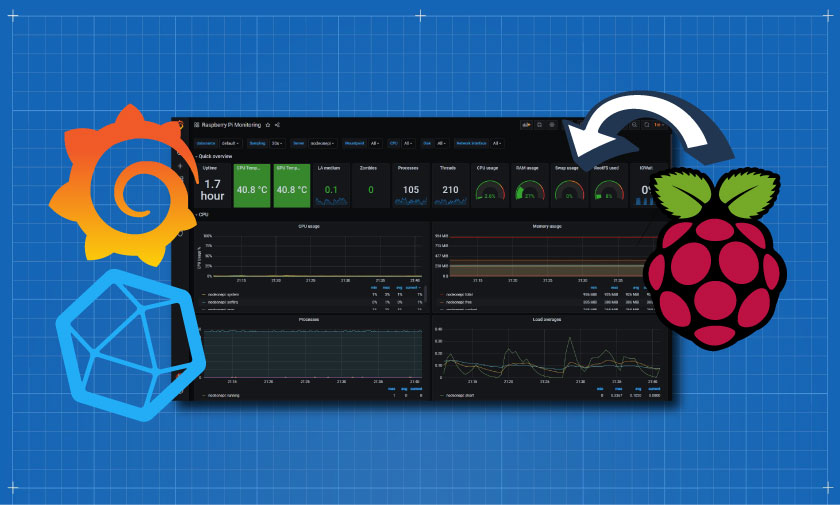Monitor Raspberry Pi Remotely: The Ultimate Guide For Tinkerers And Tech Enthusiasts
So, you've got this tiny powerhouse called a Raspberry Pi, and you're wondering how to monitor it remotely? Well, buckle up because we're diving deep into the world of remote Raspberry Pi monitoring. Whether you're a tech enthusiast, a hobbyist, or someone who just loves playing around with gadgets, this guide is for you. We'll break down the basics, tools, techniques, and even some cool tricks to make your life easier. Let's get started, shall we?
Monitoring your Raspberry Pi from afar isn't just about convenience—it's about control. Imagine being able to check on your Pi's performance, tweak settings, or troubleshoot issues without having to physically touch the device. Sounds pretty awesome, right? In this article, we'll explore everything you need to know about remote monitoring, including the best tools, step-by-step guides, and some insider tips to keep your Pi running smoothly.
Now, before we dive into the nitty-gritty, let's set the stage. This guide isn't just for the pros; it's for anyone who wants to level up their Raspberry Pi game. Whether you're setting up a home server, running a media center, or building a smart home system, remote monitoring is a game-changer. So grab a cup of coffee, and let's get to it!
Read also:Junko Firuta
What Does "Monitor Raspberry Pi Remotely" Even Mean?
Alright, let's start with the basics. When we talk about monitoring your Raspberry Pi remotely, we're referring to the ability to access, control, and check the status of your Pi from anywhere in the world. This could mean checking CPU usage, disk space, network activity, or even running commands without being physically present. It's like having a remote control for your Pi, but way cooler.
Remote monitoring isn't just about convenience. It's about efficiency. Think about it: you can troubleshoot issues, update software, or even reboot your Pi without leaving your couch. And if you're managing multiple Pis, remote monitoring becomes an absolute necessity.
Why Should You Monitor Your Raspberry Pi Remotely?
- Convenience: Who doesn't love being able to do things from the comfort of their own home?
- Efficiency: Save time by managing your Pi from anywhere.
- Security: Keep an eye on your Pi's performance and security status.
- Flexibility: Whether you're at work, on vacation, or just chilling at a café, you can still keep tabs on your Pi.
And let's not forget the cool factor. Being able to monitor and control your Raspberry Pi remotely makes you look like a tech wizard to your friends and family. Trust me, they'll be impressed.
Getting Started: Setting Up Your Raspberry Pi for Remote Access
Before you can start monitoring your Raspberry Pi remotely, you need to set it up for remote access. This involves a few key steps, including enabling SSH, setting up a static IP address, and configuring port forwarding if necessary. Don't worry if that sounds complicated—we'll break it down for you.
Step 1: Enable SSH on Your Raspberry Pi
SSH (Secure Shell) is the backbone of remote access. It allows you to connect to your Raspberry Pi securely from another device. To enable SSH, follow these simple steps:
- Boot up your Raspberry Pi and log in.
- Open the terminal and type
sudo raspi-config. - Navigate to "Interfacing Options" and select "SSH".
- Choose "Enable" and exit the configuration tool.
And just like that, SSH is up and running on your Pi. Easy, right?
Read also:Fallon Natalie Love Real Name The Untold Story You Need To Know
Step 2: Set Up a Static IP Address
A static IP address ensures that your Raspberry Pi always has the same network address, making it easier to connect remotely. Here's how to set it up:
- Open the terminal and type
sudo nano /etc/dhcpcd.conf. - Scroll to the bottom of the file and add the following lines:
interface eth0
static ip_address=192.168.1.100/24
static routers=192.168.1.1
static domain_name_servers=192.168.1.1
Save and exit by pressing Ctrl+X, then Y, and Enter. Reboot your Pi for the changes to take effect.
The Best Tools for Monitoring Raspberry Pi Remotely
Now that your Raspberry Pi is set up for remote access, let's talk about the tools you can use to monitor it. There are tons of options out there, but we've narrowed it down to the best ones for you.
1. SSH (Secure Shell)
As we mentioned earlier, SSH is the go-to tool for remote access. It's secure, reliable, and easy to use. With SSH, you can run commands, transfer files, and even edit configuration files remotely. Plus, it's already built into most Linux distributions, including Raspberry Pi OS.
2. VNC (Virtual Network Computing)
If you prefer a graphical interface, VNC is the way to go. It allows you to view and control your Raspberry Pi's desktop remotely, just like you would if you were sitting in front of it. To set up VNC, simply install the VNC server on your Pi and connect using a VNC client on your computer or mobile device.
3. Web-Based Monitoring Tools
For a more user-friendly experience, consider using a web-based monitoring tool like Pi-hole or Grafana. These tools provide real-time data visualization and allow you to monitor your Pi's performance from any device with a web browser.
Advanced Techniques for Remote Monitoring
Once you've mastered the basics, it's time to level up your remote monitoring game. Here are a few advanced techniques to take your skills to the next level:
1. Set Up a Dynamic DNS
If you don't have a static public IP address, setting up a Dynamic DNS (DDNS) can help you access your Raspberry Pi from anywhere. Services like No-IP or DynDNS allow you to assign a hostname to your Pi's IP address, making it easier to connect remotely.
2. Use a Remote Desktop Protocol (RDP)
RDP is another option for remote graphical access. While it's more commonly used on Windows systems, it can also be set up on your Raspberry Pi with a bit of tweaking. This method is especially useful if you're working with multiple devices or need more advanced features.
3. Automate Tasks with Cron Jobs
Cron jobs allow you to schedule tasks to run automatically at specified intervals. This can be incredibly useful for monitoring your Pi's performance, running backups, or even restarting services if they crash. To set up a cron job, simply edit the crontab file using the command crontab -e.
Best Practices for Secure Remote Monitoring
While remote monitoring is convenient, it's important to prioritize security. Here are a few best practices to keep your Raspberry Pi safe:
- Use strong passwords: Avoid using easily guessable passwords and consider enabling two-factor authentication.
- Keep your software up to date: Regularly update your Pi's operating system and installed software to patch security vulnerabilities.
- Restrict access: Limit who can connect to your Pi by using firewalls or IP whitelisting.
By following these best practices, you can enjoy the benefits of remote monitoring without compromising your security.
Common Issues and Troubleshooting
Even with the best setup, things can go wrong. Here are some common issues you might encounter when monitoring your Raspberry Pi remotely and how to fix them:
1. Can't Connect via SSH
If you're unable to connect to your Pi via SSH, double-check that SSH is enabled and that your IP address is correct. Also, ensure that your firewall isn't blocking the connection.
2. Slow Performance
Remote monitoring can sometimes cause your Pi to slow down, especially if you're running resource-intensive applications. To improve performance, consider upgrading your Pi's hardware or optimizing your software.
3. Security Concerns
If you're worried about security, consider using a VPN to encrypt your connection or limiting access to trusted devices only.
Conclusion: Take Control of Your Raspberry Pi Today
That's a wrap, folks! We've covered everything you need to know about monitoring your Raspberry Pi remotely, from the basics to advanced techniques. Whether you're a seasoned pro or just starting out, remote monitoring is a powerful tool that can help you get the most out of your Pi.
So what are you waiting for? Get out there and start monitoring your Raspberry Pi like a pro. And don't forget to share this article with your friends and fellow tech enthusiasts. Who knows? You might just inspire someone else to join the Raspberry Pi revolution.
Table of Contents
- What Does "Monitor Raspberry Pi Remotely" Even Mean?
- Getting Started: Setting Up Your Raspberry Pi for Remote Access
- The Best Tools for Monitoring Raspberry Pi Remotely
- Advanced Techniques for Remote Monitoring
- Best Practices for Secure Remote Monitoring
- Common Issues and Troubleshooting
- Conclusion: Take Control of Your Raspberry Pi Today
Article Recommendations


